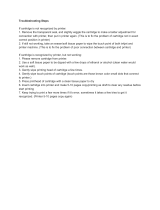
ii
Table of Contents
INTRODUCTION
Using this guide ...................................v
Important safety instructions.............vi
For your safety (Australia only) .......viii
Caution (New Zealand only) .............viii
1 SETTING UP
Unpacking......................................... 1-1
Removing the shipping materials.....................1-2
Assembling the fax .......................... 1-3
Attaching components .....................................1-3
Making connections......................... 1-4
Connecting the telephone line, handset, and
external devices...........................................1-4
Connecting the AC power cord.........................1-5
Setting the language.........................................1-5
Loading paper................................... 1-6
Paper guidelines...............................................1-6
Loading paper in the multi-purpose tray ..........1-7
Installing the BJ cartridge ............... 1-8
Guidelines ........................................................1-8
Installing the BJ cartridge in your fax...............1-9
Testing the fax................................................1-10
2 PREPARING TO USE
YOUR FAX
Main components of your fax ......... 2-1
Fax controls - the operation panel.. 2-2
Guidelines for entering
numbers, letters, and symbols.... 2-4
Correcting mistakes .........................................2-5
Setting the TEL LINE TYPE ............. 2-6
Dialing through a switchboard
(PBX).............................................. 2-6
Registering the access type and the outside line
access number ............................................2-7
Registering sender information ...... 2-8
Personalizing your fax......................................2-8
Setting the date and time .................................2-8
Registering your fax/telephone number and
name............................................................2-9
Setting the summer time................................2-10
Registering one-touch speed dialing
numbers and names................... 2-12
Registering coded speed dialing
numbers and names................... 2-14
Registering UCanTalk
voice tags .................................... 2-15
Registering voice tags with one-touch/coded
speed dialing numbers and names............ 2-15
Adding voice tags to the one-touch/coded speed
dialing numbers ........................................ 2-15
Modifying voice tags......................................2-16
Deleting voice tags.........................................2-16
3
DOCUMENTS AND PAPER
Preparing documents....................... 3-1
Types of documents you can scan...................3-1
Problem documents ........................................3-1
Loading documents ......................... 3-2
Problems with multipage documents .............. 3-2
Paper requirements.......................... 3-3
Printable area...................................................3-3
Loading paper.................................................. 3-3
4 MAKING COPIES
Copying documents ......................... 4-1
5 SENDING DOCUMENTS
Preparing to send a document........ 5-1
Adjusting the quality of your documents ......... 5-1
Sending methods............................................. 5-2
Dialing methods............................................... 5-2
Sending documents ......................... 5-2
Direct sending.................................................. 5-2
Memory sending..............................................5-3
Manual sending ...............................................5-4
Canceling sending............................ 5-5
Automatic dialing ............................. 5-5
Sending a document using one-touch speed
dialing or coded speed dialing numbers...... 5-5
Sending a document using directory dialing.... 5-6
Sending a document using UCanTalk .............. 5-7
Special dialing .................................. 5-8
Sending a document using caller history......... 5-8
Long-distance dialing ......................................5-8
Redialing when the line is busy ...... 5-9
Manual redialing .............................................. 5-9
Automatic redialing..........................................5-9
Delayed sending ............................. 5-11
Sending other documents while the fax is set for
delayed sending ........................................ 5-12
Canceling delayed sending.............................5-12
Sequential broadcasting................ 5-13
Sending a document to more than
one location...............................................5-13
Documents stored in memory....... 5-14




















